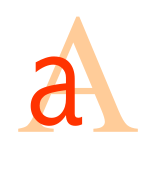
Back Hoofletter Afrikaans نسق الحرف Arabic ছোট ও বড় হাতের অক্ষর Bengali/Bangla Escriptura de dues caixes Catalan Uskleco Esperanto Aakkoslaji Finnish Écriture bicamérale French אותיות רישיות ואותיות קטנות HE लेटर केस Hindi Kis- és nagybetűk Hungarian
This article needs additional citations for verification. (December 2023) |

Letter case is the distinction between the letters that are in larger uppercase or capitals (or more formally majuscule) and smaller lowercase (or more formally minuscule) in the written representation of certain languages. The writing systems that distinguish between the upper- and lowercase have two parallel sets of letters: each in the majuscule set has a counterpart in the minuscule set. Some counterpart letters have the same shape, and differ only in size (e.g. ⟨C, c⟩ or ⟨S, s⟩), but for others the shapes are different (e.g., ⟨A, a⟩ or ⟨G, g⟩). The two case variants are alternative representations of the same letter: they have the same name and pronunciation and are typically treated identically when sorting in alphabetical order.
Letter case is generally applied in a mixed-case fashion, with both upper and lowercase letters appearing in a given piece of text for legibility. The choice of case is often prescribed by the grammar of a language or by the conventions of a particular discipline. In orthography, the uppercase is primarily reserved for special purposes, such as the first letter of a sentence or of a proper noun (called capitalisation, or capitalised words), which makes the lowercase the more common variant in regular text.
In some contexts, it is conventional to use one case only. For example, engineering design drawings are typically labelled entirely in uppercase letters, which are easier to distinguish individually than the lowercase when space restrictions require very small lettering. In mathematics, on the other hand, uppercase and lower case letters denote generally different mathematical objects, which may be related when the two cases of the same letter are used; for example, x may denote an element of a set X.
© MMXXIII Rich X Search. We shall prevail. All rights reserved. Rich X Search